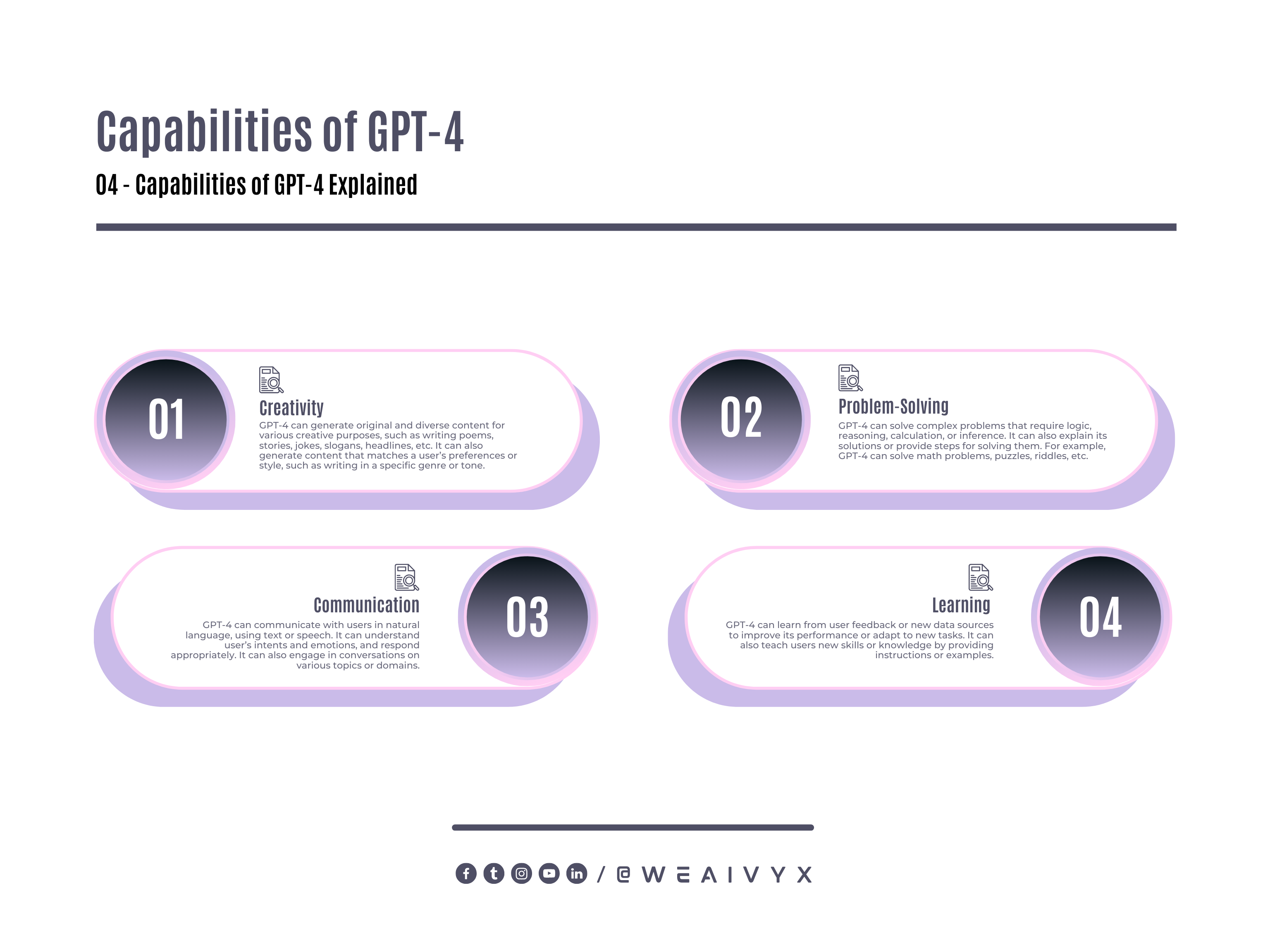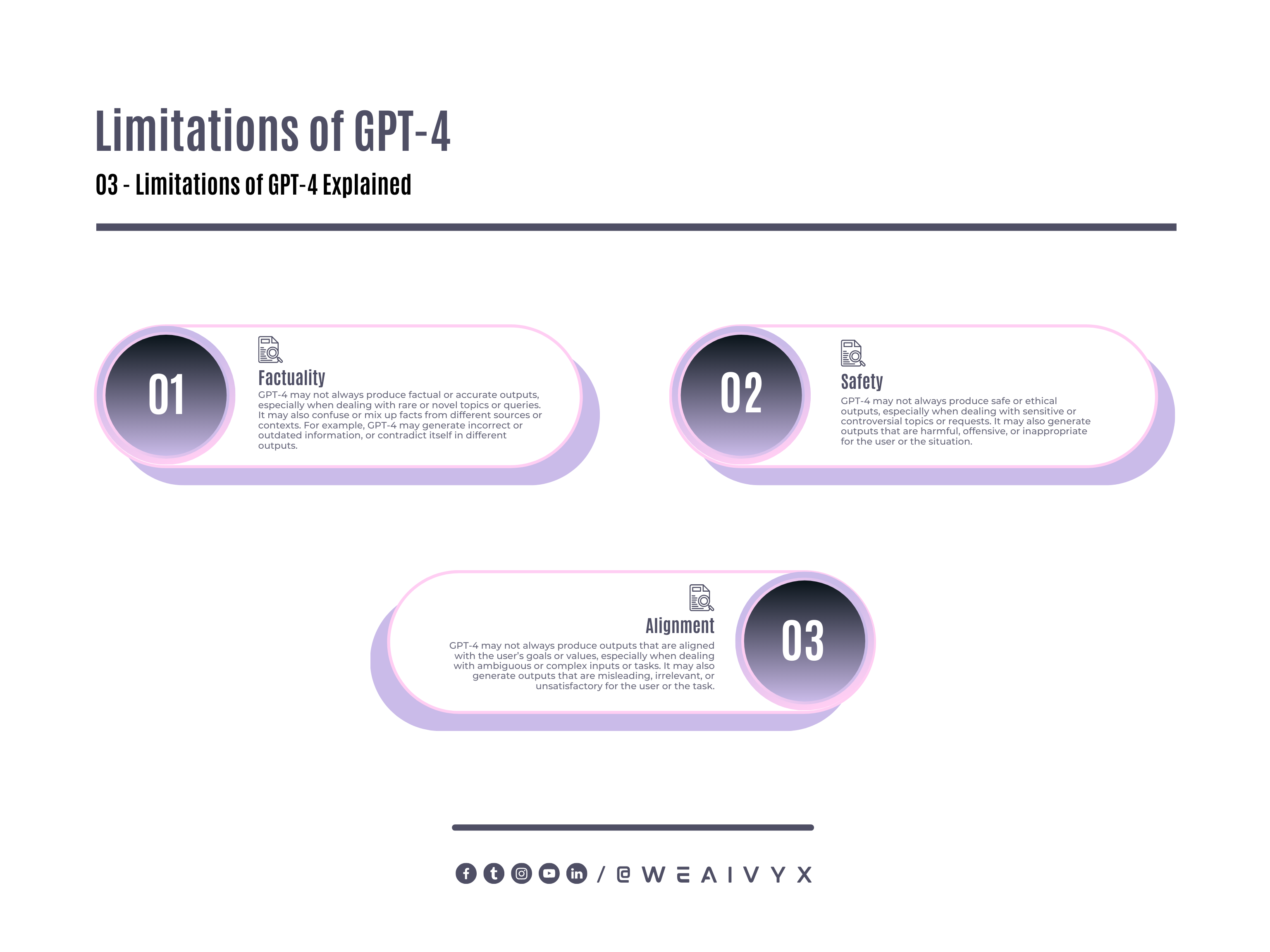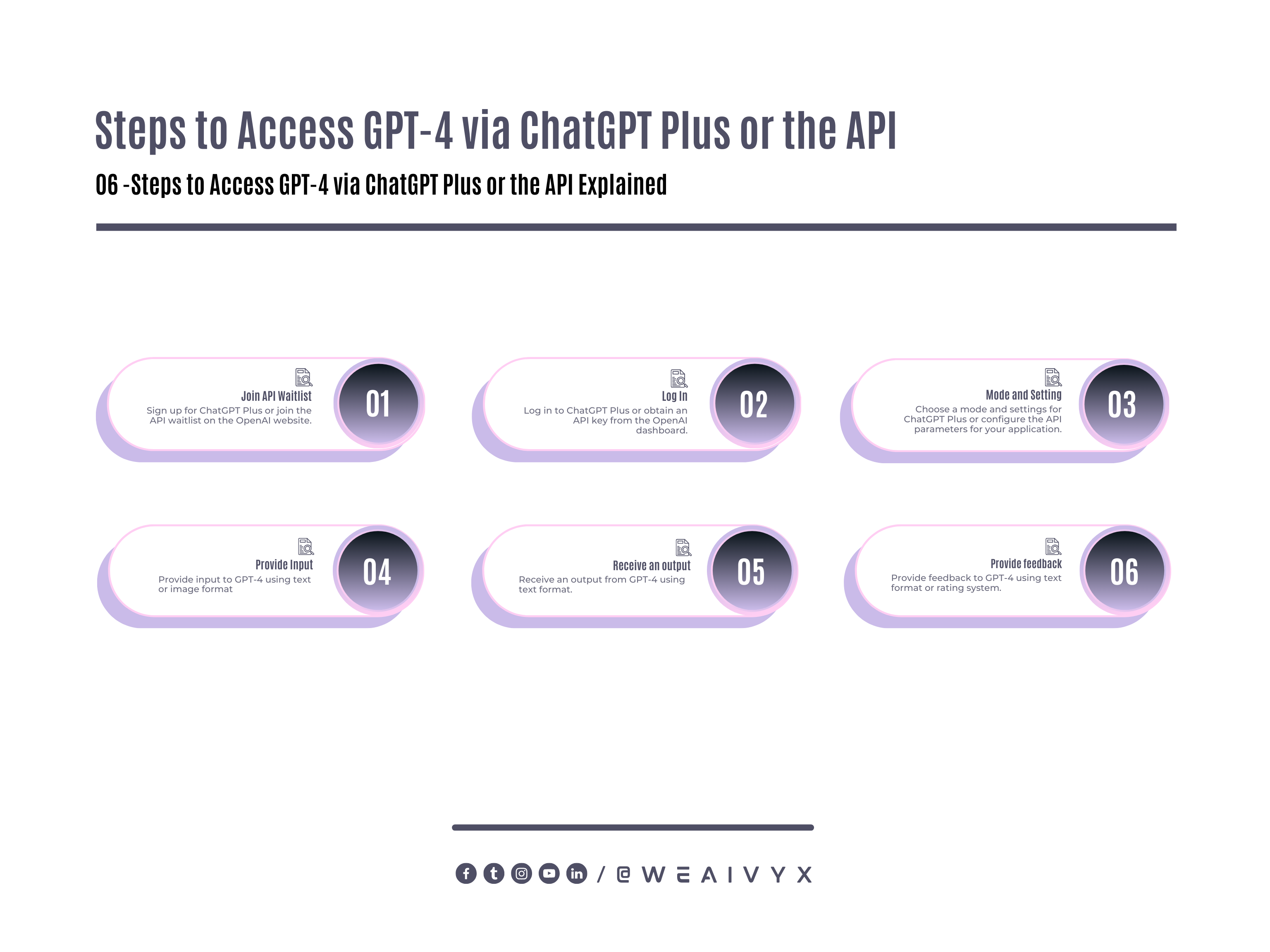GPT-4 is the latest and most advanced system from OpenAI, a research organization dedicated to creating and ensuring the safe and beneficial use of artificial intelligence.
GPT-4 is a large multimodal model, which means it can accept both text and image inputs, and produce text outputs.
GPT-4 is capable of generating, editing, and iterating with users on various creative and technical writing tasks, such as composing songs, writing screenplays, or learning a user’s writing style.
It can also solve difficult problems with greater accuracy than any of the previous models, thanks to its broader general knowledge and advanced reasoning abilities.
What is GPT-4
GPT-4 stands for Generative Pre-trained Transformer 4, which is a type of neural network architecture that uses attention mechanisms to learn from large amounts of data.
GPT-4 is a continuation of the research path from GPT, GPT-2, and GPT-3, which were previous versions of the same model with different sizes and capabilities.
GPT-4 is trained on a massive corpus of text and images from the internet, using more data and more computation than ever before.
It has 100 trillion parameters, which is 10 times more than GPT-3.5, the previous state-of-the-art model.
How Does It Work?
GPT-4 is based on the principle of self-attention, which means it can learn the relationships between different parts of the input and output sequences.
For example, if the input is a sentence, GPT-4 can learn which words are related to each other based on their context and position. If the input is an image, GPT-4 can learn which pixels are related to each other based on their color and shape.
GPT-4 can also learn from multiple modalities, such as text and images, by combining them into a single representation.
GPT-4 is a generative model, which means it can produce new content that is coherent and relevant to the input.
For example, if the input is a prompt for a song lyric, GPT-4 can generate a complete song that matches the style and theme of the prompt. If the input is a question, GPT-4 can generate an answer that is factual and informative.
GPT-4 can also generate multiple outputs for the same input, allowing users to choose the best one or iterate further.
GPT-4 is a pre-trained model, which means it has already learned from a large amount of data before being used for specific tasks.
This allows GPT-4 to have a general understanding of language and images, as well as common sense and world knowledge.
However, GPT-4 can also be fine-tuned for specific domains or applications, by training it on additional data that is relevant to the task.
For example, GPT-4 can be fine-tuned for legal or medical domains, by training it on legal or medical documents.
What Makes It Different
It is a better version of ChatGPT 3.5 and it gives more features than its predecessor. Unlike ChatGPT 3.5 it can also accept images as input but this feature was not available in ChatGPT 3.5.
The previous version was only able to accept the text as its input. Many changes have also been made to it.
It can now generate text longer than 25000 words which is far more than the number of words generated by its previous version.
It also allows you to generate images from text prompts which is also something new.
Paid Version
ChatGPT-4 is a powerful and advanced chatbot that can generate creative and engaging content on various topics.
It is based on the GPT-4 model, which is one of the largest and most sophisticated language models in the world.
If you want to experience the full potential of ChatGPT-4, you need to subscribe to the Plus version of ChatGPT.
The Plus version allows you to access ChatGPT-4 directly and enjoy unlimited conversations with it.
You can also customize your chat settings and preferences, such as the mode, language, and tone of the chatbot.
The Plus version costs 20 dollars per month and it is only available for a limited number of users at the moment.
If you are interested in using ChatGPT-4 for commercial purposes, such as developing applications or websites that use its features, you need to join the API Waitlist.
The API Waitlist is a queue of developers and businesses who want to access the ChatGPT-4 API and integrate it with their platforms.
The API Waitlist is currently closed for new entries, as Chat GPT-4 is still in beta testing and development.
However, you can sign up for updates and notifications about the API Waitlist on the ChatGPT website.
Capabilities of GPT-4
GPT-4 is a powerful and versatile system that can perform various tasks across different domains and modalities. Some of the capabilities of GPT-4 include
Creativity
GPT-4 can generate original and diverse content for various creative purposes, such as writing poems, stories, jokes, slogans, headlines, etc.
It can also generate content that matches a user’s preferences or style, such as writing in a specific genre or tone.
Problem-Solving
GPT-4 can solve complex problems that require logic, reasoning, calculation, or inference. It can also explain its solutions or provide steps for solving them.
For example, GPT-4 can solve math problems, puzzles, riddles, etc.
Communication
GPT-4 can communicate with users in natural language, using text or speech. It can understand user’s intents and emotions, and respond appropriately. It can also engage in conversations on various topics or domains.
Learning
GPT-4 can learn from user feedback or new data sources to improve its performance or adapt to new tasks.
It can also teach users new skills or knowledge by providing instructions or examples.

Limitations of GPT-4
ChatGPT-4 also has some limitations that can cause problems for the user. Some of the limitations of GPT-4 include:
Factuality
GPT-4 may not always produce factual or accurate outputs, especially when dealing with rare or novel topics or queries. It may also confuse or mix up facts from different sources or contexts.
For example, GPT-4 may generate incorrect or outdated information, or contradict itself in different outputs.
Safety
GPT-4 may not always produce safe or ethical outputs, especially when dealing with sensitive or controversial topics or requests.
It may also generate outputs that are harmful, offensive, or inappropriate for the user or the situation.
For example, GPT-4 may generate content that is violent, abusive, hateful, discriminatory, illegal, etc.
Alignment
GPT-4 may not always produce outputs that are aligned with the user’s goals or values, especially when dealing with ambiguous or complex inputs or tasks.
It may also generate outputs that are misleading, irrelevant, or unsatisfactory for the user or the task.
For example, GPT-4 may generate content that is biased, incomplete, vague, boring, etc.

How Can You Access and Use GPT-4 via ChatGPT Plus or the API?
GPT-4 is currently available via two platforms: ChatGPT Plus and the API.
ChatGPT Plus is a web-based interface that allows users to interact with GPT-4 using text inputs and outputs.
Users can choose from different modes and settings to customize their experience and control the behavior of GPT-4.
Users can also provide feedback to GPT-4 to help it improve its outputs or learn new skills. ChatGPT Plus is free to use for anyone who signs up with an email address.
The API is a programmatic interface that allows developers to integrate GPT-4 into their applications or services using text and image inputs and outputs.
Developers can access the API by joining the waitlist and obtaining an API key.
The API is currently in beta and has a limited number of seats and usage limits. The API is also subject to pricing and terms of service.
Steps
To access and use GPT-4 via ChatGPT Plus or the API, users need to follow these steps:
Sign up for ChatGPT Plus or join the API waitlist on the OpenAI website.
Log in to ChatGPT Plus or obtain an API key from the OpenAI dashboard.
Choose a mode and settings for ChatGPT Plus or configure the API parameters for your application.
Provide input to GPT-4 using text or image format.
Receive an output from GPT-4 using text format.
Provide feedback to GPT-4 using text format or rating system.

How Can You Contribute to the Improvement and Safety of GPT-4?
GPT-4 is a work in progress and has room for improvement and safety. OpenAI welcomes feedback and contributions from users and developers to help make GPT-4 better and safer for everyone.
Some of the ways you can contribute to the improvement and safety of GPT-4 include:
Reporting bugs, errors, failures, or shortcomings in GPT-4’s outputs using the feedback system on ChatGPT Plus or the API dashboard.
Submitting suggestions, ideas, requests, or use cases for GPT-4’s capabilities, features, modes, settings, etc. using the feedback system on ChatGPT Plus or the API dashboard.
Participating in surveys, experiments, evaluations, or studies conducted by OpenAI or its partners to test and measure GPT-4’s performance, behavior, safety, etc.
Contributing to OpenAI Evals, an open-source framework for automated evaluation of AI model performance, by creating new benchmarks, metrics, datasets, etc. for GPT-4 or other models.
Following the best practices and guidelines for using GPT-4 responsibly and ethically, such as respecting user privacy and consent, avoiding harmful or illegal content, acknowledging limitations and uncertainties, etc.
What Are Some of the Ethical and Social Implications of GPT-4?
GPT-4 is a powerful and versatile system that can have significant impacts on various aspects of society and human life.
While GPT-4 can bring many benefits and opportunities for individuals and organizations, it can also pose many challenges and risks for society and humanity.
Some of the ethical and social implications of GPT-4 include:
Trust: How can users trust the outputs of GPT-4? How can users verify the sources, accuracy, reliability, quality, etc. of GPT-4’s outputs? How can users distinguish between human-generated and machine-generated content?
Accountability: Who is responsible for the outputs of GPT-4? Who is liable for the consequences of using GPT-4? Who is accountable for the oversight and regulation of GPT-4?
Fairness: How can users ensure that GPT-4 is fair and unbiased? How can users prevent or mitigate bias, discrimination, inequality, injustice, etc. caused by GPT-4? How can users promote diversity, inclusion, equity, justice, etc. with GPT-4?
Privacy: How can users protect their privacy and security when using GPT-4? How can users control the access, use, and sharing of their data and content with GPT-4? How can users prevent or detect unauthorized or malicious use of GPT-4?
Creativity: How can users enhance their creativity and originality with GPT-4? How can users avoid plagiarism, copying, or imitation of GPT-4’s outputs? How can users foster collaboration and co-creation with GPT-4?
Education: How can users learn from and with GPT-4? How can users teach GPT-4 new skills or knowledge? How can users evaluate the learning outcomes of GPT-4?
Employment: How can users leverage GPT-4 for their work or career? How can users cope with the changes or disruptions caused by GPT-4 in the labor market? How can users balance the benefits and costs of using GPT-4 for their work or career?
Society: How can users use GPT-4 for social good or social change? How can users prevent or address the social problems or issues caused by GPT-4? How can users ensure that GPT-4 is aligned with the values and norms of society?
Conclusion
GPT-4 is a remarkable achievement in artificial intelligence research and development.
It is a system that can generate, edit, and iterate with users on various creative and technical writing tasks, as well as solve difficult problems with greater accuracy than any of the previous models.
It is also a system that can accept both text and image inputs, and produce text outputs. However, GPT-4 is not perfect and has limitations and challenges that need to be addressed.
It is also a system that has ethical and social implications that need to be considered.
To access and use GPT-4, users can sign up for ChatGPT Plus or join the API waitlist on the OpenAI website.
Users can also provide feedback and contributions to help improve and safeguard GPT-4. Users should also follow the best practices and guidelines for using GPT-4 responsibly and ethically.
GPT-4 is a system that can open up new possibilities and opportunities for individuals and organizations, as well as society and humanity.
It is also a system that can pose new risks and challenges for individuals and organizations, as well as society and humanity.
It is up to us to use GPT-4 wisely and well, for the benefit of all.
